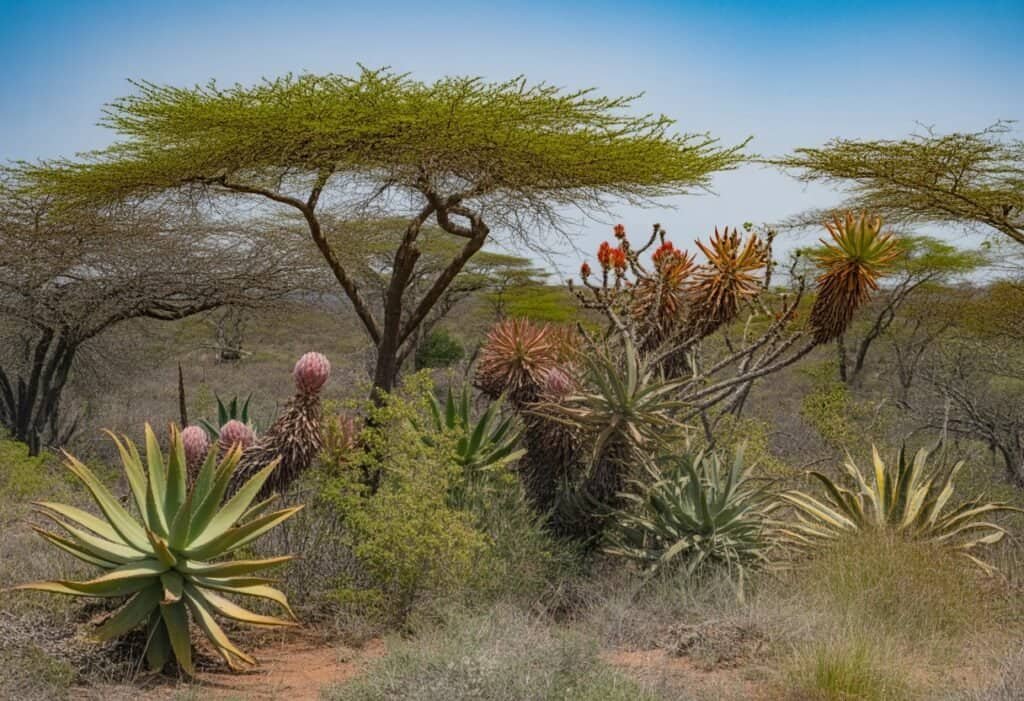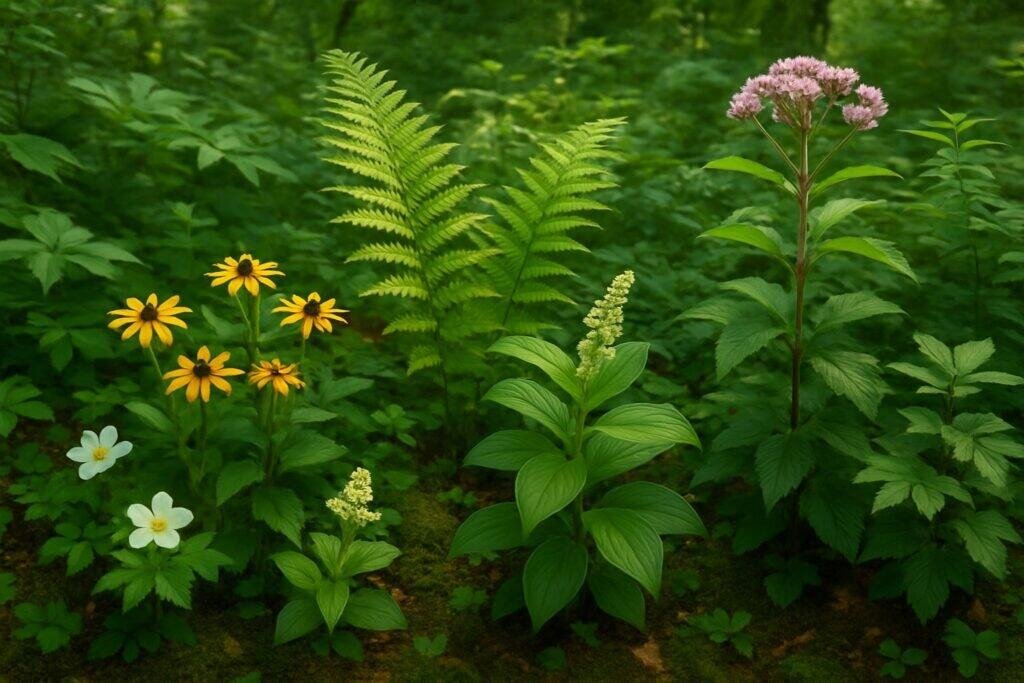Africa’s plant life is as diverse as its landscapes. From the towering baobabs to delicate desert blooms, the continent hosts thousands of unique native plant species.
These plants have adapted to survive in environments ranging from arid deserts to lush rainforests.
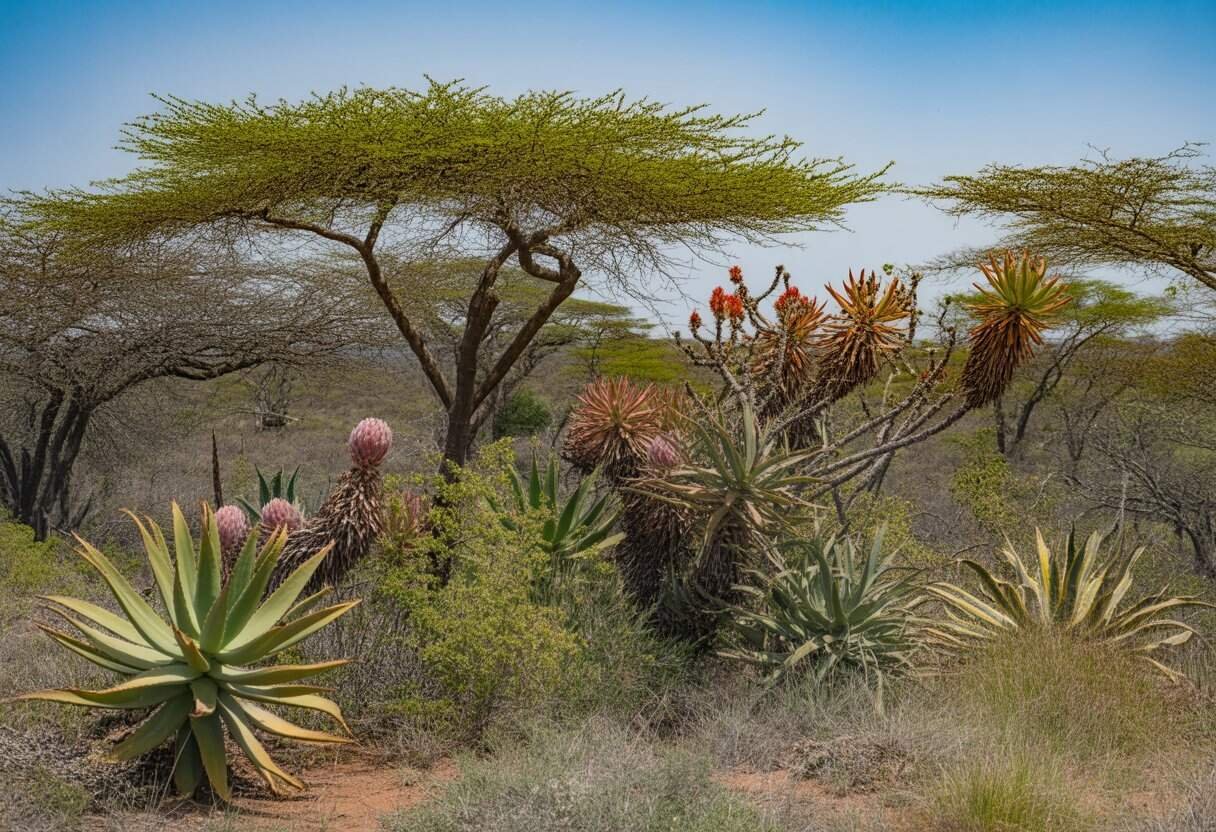
Many African native plants offer valuable resources for food, medicine, and materials. For example, the baobab tree produces fruit with more vitamin C than oranges.
Aloe vera has served healing purposes for centuries. These plants have shaped African ecosystems and cultures.
The native flora of Africa faces challenges from climate change, habitat loss, and invasive species. Conservation efforts aim to protect these botanical treasures that have evolved over millions of years.
Key Takeaways
- Africa is home to thousands of native plant species adapted to diverse environments from deserts to rainforests.
- Native African plants provide essential food, medicine, and materials while supporting unique wildlife ecosystems.
- Conservation efforts are crucial to protect Africa’s botanical diversity from threats like habitat loss and climate change.
Overview of Plants Native to Africa
Africa’s diverse landscapes host an extraordinary variety of native plant species. These plants have adapted to thrive in specific conditions while playing crucial roles in local ecosystems and human communities.
Defining Native African Plants
Native African plants are species that originated within Africa’s borders and evolved there over thousands of years. These plants developed without human intervention and adapted to local soil conditions, rainfall patterns, and temperature ranges.
Unlike introduced species, native plants have deep genetic connections to their environments. They usually need less water and maintenance because they evolved alongside local climate patterns.
Africa’s plant biodiversity is impressive, with at least 45,000 plant species identified across the continent. This represents about 15-20% of the world’s known plant species.
The Cape Floristic Region in South Africa alone contains over 9,000 plant species. Nearly 70% of these species grow nowhere else on Earth.
Major Plant Species by Region
Africa’s plant distribution varies dramatically by region. Each area hosts unique native species.
North Africa/Sahara:
- Date palm (Phoenix dactylifera)
- Acacia trees
- Desert-adapted succulents
West African Rainforests:
- African tulip tree (Spathodea campanulata)
- Oil palm (Elaeis guineensis)
- Cola trees that produce caffeine-rich nuts
East African Savannas:
- Baobab trees (Adansonia species)
- Umbrella thorn acacia (Vachellia tortilis)
- Red oat grass (Themeda triandra)
Southern Africa:
- Protea flowers
- Rooibos (Aspalathus linearis)
- Aloe species including Aloe vera
Each plant has developed unique adaptations. Baobabs store water in their massive trunks.
Desert plants have reduced leaves to minimize water loss.
Significance for African Ecosystems
Native plants form the foundation of Africa’s ecosystems. They provide food and habitat for wildlife while stabilizing soil and regulating water cycles.
Many species serve as keystone plants. Acacia trees in savannas fix nitrogen in soil and provide food for animals from insects to giraffes.
African plants also help capture carbon. The Congo Basin rainforest, second only to the Amazon, absorbs billions of tons of carbon dioxide each year.
These plants support human communities. About 80% of rural Africans rely on traditional plant-based medicines for healthcare.
Native plants also help ensure food security. Indigenous crops like sorghum, millet, and cowpeas are naturally drought-resistant and nutritious.
Iconic African Trees and Succulents
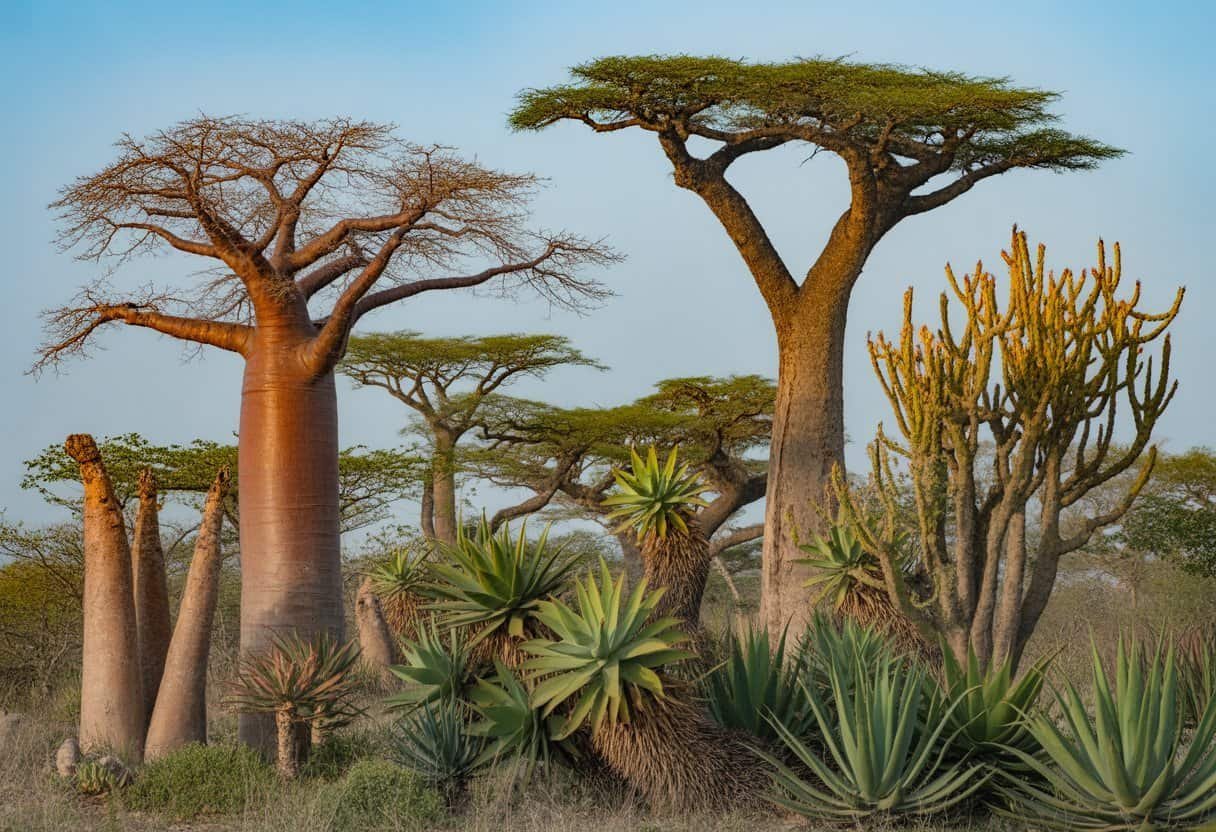
Several distinctive tree and succulent species define Africa’s landscape. These plants shape the continent’s scenery and hold significant cultural and ecological importance.
Baobab and Baobab Tree
The baobab tree (Adansonia) stands as one of Africa’s most recognizable symbols. Its massive trunk can reach up to 11 meters in diameter and dominates savannas across the continent.
Baobabs can live for thousands of years, earning them the nickname “Tree of Life.” During dry seasons, baobabs store water in their trunks, sometimes holding up to 120,000 liters.
This adaptation helps them survive prolonged droughts common in African regions. The tree produces nutrient-rich fruits with seeds surrounded by powdery pulp.
This pulp contains six times more vitamin C than oranges and is commonly used in foods and beverages. Local communities use every part of the baobab.
The bark provides fiber for rope and cloth. Leaves and fruits offer medicinal properties for treating fevers and digestive issues.
Quiver Tree and Aloe Varieties
The quiver tree (Aloidendron dichotomum) is a large succulent, not a true tree. San people hollowed branches to make quivers for their arrows.
These plants grow mainly in South Africa and Namibia. Quiver trees can reach up to 9 meters tall and have forked branches topped with rosettes of succulent leaves.
Their yellow flowers attract birds and insects that help with pollination. Bitter aloe (Aloe ferox) is another important African succulent.
This plant produces red-orange flowers on tall stalks and contains gel used in cosmetics and medicines. Africa has over 500 aloe species.
Most aloes have thick, water-storing leaves with spiny edges. These plants thrive in rocky, arid environments where few other species can survive.
Coral Trees and Other Notable Trees
Coral trees (Erythrina species) add vibrant color to African landscapes with their bright red flowers. These trees supply nectar for birds and insects during flowering seasons.
The yellowwood tree (Podocarpus) is South Africa’s national tree. This ancient species can live for over 1,000 years.
Acacia trees define many African savannas with their flat-topped canopies. Their thorns protect against browsing animals, and deep roots reach underground water.
The African blackwood (Dalbergia melanoxylon) produces valuable timber. Musicians use this dense, dark wood for woodwind instruments, but overharvesting has threatened its populations.
Famous Native African Flowers
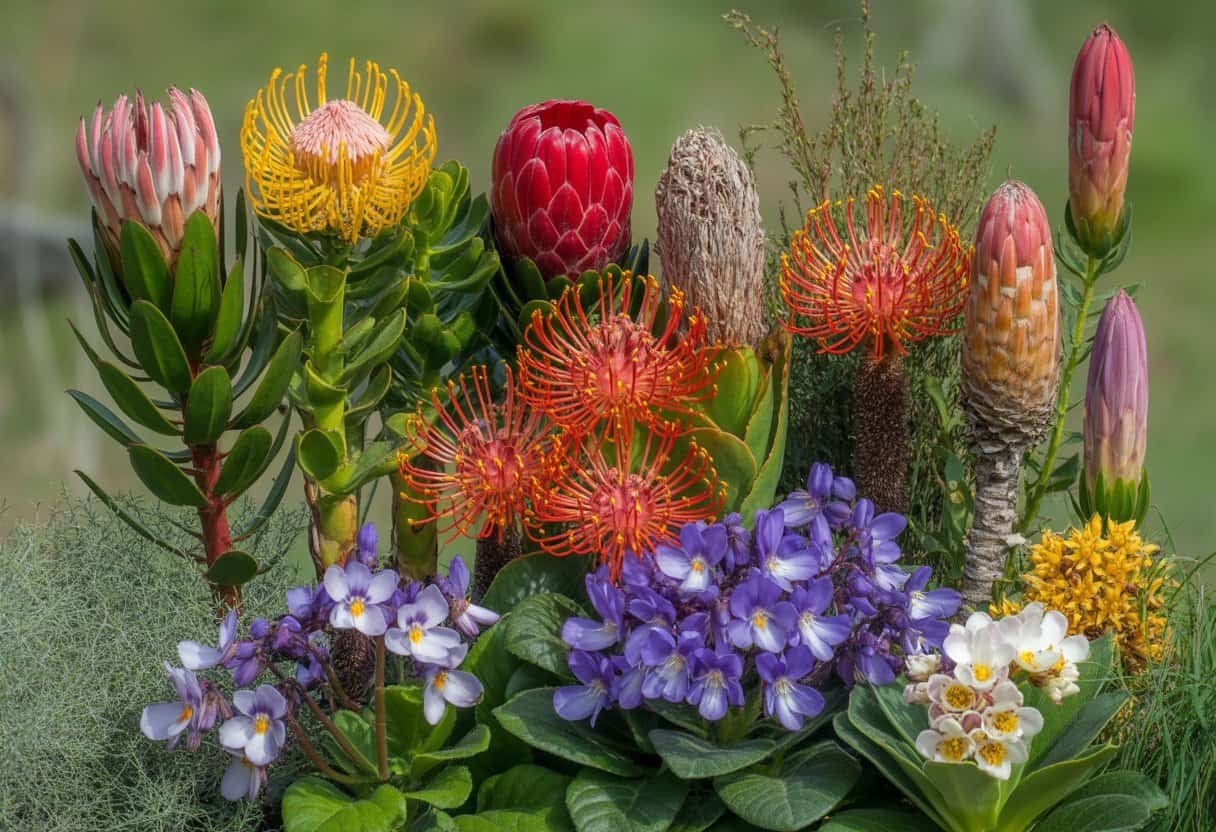
Africa’s diverse landscapes are home to some of the world’s most distinctive and beautiful flowering plants. These native blooms have gained worldwide recognition for their unique shapes, vibrant colors, and remarkable adaptations to various African environments.
Bird of Paradise (Strelitzia reginae)
The Bird of Paradise is one of Africa’s most iconic flowers. It is native to South Africa’s eastern coast.
Its striking orange and blue blooms resemble an exotic bird in flight, giving the plant its memorable name. This flower grows from a thick, underground stem and can reach heights of 3-5 feet.
The Bird of Paradise thrives in full sun and mild temperatures. Many gardeners worldwide now cultivate this plant for its dramatic appearance.
The flower’s structure serves an ecological purpose. When birds land to drink nectar, the petals open and cover the bird’s feet in pollen.
This design ensures effective pollination in the wild. In South African traditional medicine, parts of the Strelitzia reginae have been used for healing.
The plant has also become a symbol of freedom, paradise, and joy in many cultures.
King Protea (Protea cynaroides)
The King Protea is South Africa’s national flower and the largest member of the Protea genus. Its massive flower heads can grow up to 12 inches in diameter.
The flower resembles a crown with stiff, petal-like bracts surrounding a fuzzy center. Colors range from creamy white to deep pink, with the most common being soft pink with white inner bracts.
These blooms can last for weeks, both on the plant and when cut. King Proteas grow naturally in the fynbos region of South Africa.
They have adapted to poor, acidic soils and dry conditions. Their thick, leathery leaves help reduce water loss.
The plant’s name comes from the Greek god Proteus, who could change his shape. This reflects the diverse appearance of different protea species.
These ancient plants have evolved over millions of years. Fossils date back 300 million years.
African Daisies and Relatives
African Daisies bring vibrant color to gardens across the world, though they originated in southern Africa. The term “African Daisy” includes several related species, mainly Arctotis and Dimorphotheca varieties.
Arctotis, sometimes called African Bush Daisy, features daisy-like flowers in bright oranges, yellows, and pinks. These drought-tolerant plants have silvery-gray foliage that reflects sunlight and conserves water.
Dimorphotheca pluvialis, known as the Rain Daisy or Cape Marigold, displays white petals with dark centers. These flowers close at night and on cloudy days, earning them the name “Weather Prophet.”
These daisies typically bloom after rainfall, creating carpets of color across African landscapes. Gardeners appreciate them worldwide for their easy care and drought tolerance.
Highlights of African Shrubs and Herbaceous Plants
Africa’s diverse ecosystems support a remarkable variety of flowering plants. These range from small houseplants to striking garden specimens.
Many of these plants have become popular worldwide for their beauty and hardiness.
African Violet and African Violets
African violets (Saintpaulia species) are small, fuzzy-leaved plants native to Tanzania and Kenya. These compact plants grow naturally in mountain rainforests with filtered light.
The typical African violet has velvety, round leaves arranged in a rosette. Their flowers bloom in shades of purple, blue, pink, and white.
African violets have become one of the world’s most popular houseplants. They thrive indoors because they prefer moderate temperatures and indirect light.
These plants flower year-round with proper care. Modern cultivars come in many sizes, from miniatures just 3 inches across to larger specimens reaching 16 inches in diameter.
Agapanthus and African Lily
Agapanthus, commonly known as African lily or Lily of the Nile, originates from South Africa. These herbaceous plants have long, strap-like leaves and tall flower stalks.
The flowers form in round clusters called umbels atop stems reaching 2-4 feet tall. Each umbel contains dozens of trumpet-shaped blooms in blue, purple, or white.
African lilies bloom during summer, creating dramatic displays in gardens. They are drought-tolerant once established, making them popular in water-wise landscaping.
These plants grow from fleshy rhizomes that store water and nutrients. This adaptation helps them survive in their native habitat’s seasonal dry periods.
Impala Lily and Gloriosa Superba
Impala lily (Adenium obesum) is a striking succulent shrub from East Africa’s dry regions. Its swollen trunk stores water, helping it thrive in harsh conditions.
The plant produces bright pink to red flowers that stand out against its thick, gray-green stems. In the wild, impala lilies can reach 10 feet tall, while potted plants stay much smaller.
Gloriosa superba, also called flame lily, is a climbing herbaceous plant found across sub-Saharan Africa. It features spectacular red and yellow flowers with curved, wrinkled petals.
The flame lily climbs by wrapping its tendril-like leaf tips around supports. Its stunning blooms appear in summer and fall, making it a favorite in tropical gardens.
Warning: Both plants contain toxic compounds. Gloriosa roots contain colchicine, a dangerous substance used with caution in medicine.
Unique Habitats and Ecosystems in Africa
Africa’s diverse landscapes host some of the world’s most remarkable plant communities. These ecosystems have evolved unique adaptations to survive in everything from extreme drought to seasonal flooding.
African Savanna Plant Life
The savanna ecosystem covers nearly half of Africa. Scattered trees rise from open grasslands.
Acacia trees dominate with their flat-topped canopies and thorny branches that deter herbivores. Baobab trees stand as iconic symbols of the savanna.
Baobabs store water in their trunks, allowing them to survive long dry seasons. Some baobabs live for over 1,000 years.
Grasses form the foundation of savanna ecosystems. Species like red oat grass and elephant grass thrive with seasonal rainfall and periodic fires.
These grasses develop deep root systems to reach underground moisture. Many savanna plants have fire-resistant bark or can resprout quickly after burning.
This adaptation helps them survive the wildfires that shape the savanna’s balance between grassland and forest.
Plants of the Namib Desert
The Namib Desert along Africa’s southwestern coast ranks among Earth’s oldest and driest deserts. Many plants here survive on fog rather than rain.
Welwitschia mirabilis is the Namib’s most extraordinary plant. This living fossil has only two continuously growing leaves and can live for over 1,000 years.
It survives by collecting moisture from fog and morning dew. Lithops, called “living stones,” look like pebbles to avoid being eaten and minimize water loss.
Their translucent “windows” let sunlight reach tissues buried beneath the soil. Quiver trees (Aloidendron dichotomum) dot the Namib with their unique silhouettes.
These succulents store water in their trunks and branches to endure harsh conditions.
South African Floral Kingdom
The Cape Floral Kingdom in South Africa is the smallest yet richest of Earth’s six floral kingdoms. It covers just 0.5% of Africa but contains nearly 20% of the continent’s plant species.
Fynbos vegetation dominates this region with over 9,000 plant species. About 69% of these grow nowhere else on Earth.
Key plant families include proteas, ericas, and restios that thrive in nutrient-poor soils. Proteas display spectacular flower heads that attract birds and insects.
The king protea, South Africa’s national flower, produces blooms up to 12 inches in diameter with pink or white petals. Fire plays a crucial role in this ecosystem.
Many fynbos plants store seeds in fire-resistant cones that only open after a blaze. Others resprout from underground structures once fire clears competing vegetation.
Native African Plants in Food and Medicine
Africa’s diverse plant life has provided sustenance and healing for generations. Many indigenous plants serve dual purposes in both culinary traditions and medicine.
Edible Fruits and Culinary Uses
Baobab fruit has a tangy, nutritious pulp rich in vitamin C. People eat it as a powder in drinks or as a flavoring for porridge.
The seeds can be roasted as a coffee substitute. Marula fruit holds cultural significance in many African communities.
Ripe marula fruits are eaten fresh or fermented into beverages like Amarula cream liqueur. The nuts inside contain protein and oil used in cooking.
Carpobrotus edulis, known as Hottentot fig, produces edible fruits with a sweet-sour taste. Indigenous peoples eat the fruits fresh or make them into preserves and jams.
Moringa leaves are nutritional powerhouses containing protein, calcium, and vitamins. People dry and powder them for soups or cook them fresh as vegetables.
The seeds produce oil used for cooking and cosmetics.
Medicinal Properties and Traditional Medicine
Devil’s claw root treats arthritis and digestive disorders in southern Africa. Its anti-inflammatory compounds make it one of Africa’s most exported medicinal plants.
Rooibos tea, grown in South Africa’s Western Cape, contains antioxidants that fight free radicals. People drink it to relieve allergies, digestive problems, and skin conditions.
African wild potato (Hypoxis) helps treat immune disorders and urinary infections. Traditional healers use it to strengthen the body’s resistance to stress.
Aloe vera, found worldwide, has deep roots in African traditional medicine. Its gel treats burns, wounds, and skin irritations.
People also use it internally to address digestive issues.
Noteworthy Plants with Practical Benefits
Shea trees produce nuts that yield butter for cooking and skincare. The butter contains vitamins A and E plus fatty acids that moisturize skin and hair.
Bitter leaf (Vernonia) serves culinary and medicinal purposes:
- Detoxifies the body
- Treats fever and malaria
- Adds distinctive flavor to soups
- Helps regulate blood sugar
Carpobrotus edulis has practical uses beyond food. The juice from its leaves treats dysentery, throat infections, and mouth ulcers.
Applied topically, it helps heal burns, wounds, and eczema. Kigelia africana (sausage tree) produces fruits used in traditional brewing.
Its extracts firm skin and treat fungal infections, making it valuable in both cultural practices and healing.
Role of Native Plants in African Wildlife and Culture
Native plants in Africa form the foundation for wildlife habitats and are deeply woven into local cultures. These plants support diverse ecosystems and feature prominently in traditional practices, medicine, and daily life.
Importance to Animals and Insects
African native plants provide essential food for wildlife. Acacia trees, with their flat-topped canopies, offer food and shelter to many animals, including giraffes and elephants.
Lions use these trees as hunting lookouts and resting spots during hot afternoons. The baobab tree supports insects and birds in its massive trunk and branches.
Its hollow centers sometimes shelter honey bees or small mammals. Grasses of the savanna feed large herbivores like zebras and wildebeests.
These herbivores sustain predators such as lions and cheetahs. Many African plants have co-evolved with specific pollinators.
The relationship between flowering plants and their insect pollinators ensures both species survive and thrive.
Plants in African Traditions and Daily Life
African communities have used native plants in ceremonies and daily practices for thousands of years. The kola nut holds special significance in West African cultures as a sign of hospitality and in important ceremonies.
Many plants serve medicinal purposes. The Devil’s Claw from southern Africa treats arthritis and digestive disorders.
Rooibos provides a caffeine-free tea with antioxidant properties. The raffia palm produces fibers for baskets, mats, and clothing.
These items support local economies and preserve cultural techniques. Certain plants mark important boundaries or serve as meeting places.
Ancient baobabs often function as community gathering spots where elders share knowledge and stories.
Growing and Conserving African Native Plants
African native plants can thrive in various settings with proper care and attention to their needs. Understanding climate requirements and conservation approaches helps preserve these unique plants for future generations.
USDA Zones and Climate Requirements
Most African native plants thrive in USDA zones 9-11, where temperatures rarely drop below freezing. Species from northern Africa often tolerate cooler conditions and may adapt to zones 7-8 with winter protection.
Desert plants like aloes and euphorbias need excellent drainage and full sun. They can handle drought but may need occasional deep watering to establish strong roots.
Tropical African plants such as Strelitzia (Bird of Paradise) and Kigelia africana (Sausage Tree) prefer humid conditions with consistent moisture. These plants benefit from regular watering and shelter from strong winds.
Mountain species often show surprising cold tolerance. Plants from Ethiopia’s highlands and South Africa’s Drakensberg region can sometimes survive brief frost in zones 8-9.
| Region | Typical USDA Zones | Notable Plants |
|---|---|---|
| North Africa | 7-10 | Atlas Cedar, Argan Tree |
| East Africa | 9-11 | Coffee Plant, Baobab |
| West Africa | 10-11 | African Oil Palm, Kola Nut |
| Southern Africa | 8-10 | Protea, Bird of Paradise |
African Native Plants as Houseplants
Many African native plants make excellent houseplants due to their striking appearance and adaptability. Snake plants (Sansevieria) are nearly indestructible, thriving in low light and needing minimal water.
African violets come from Tanzania and Kenya’s shaded forests. They produce colorful blooms year-round with bright, indirect light and consistent moisture.
Easy-care options include:
- Zamioculcas zamiifolia (ZZ Plant)
- Crassula ovata (Jade Plant)
- Chlorophytum comosum (Spider Plant)
These plants tolerate irregular watering and adapt to average home temperatures. Most prefer well-draining soil with perlite or sand.
Larger plants like Ficus lyrata (Fiddle Leaf Fig) and Dracaena marginata create dramatic focal points in big rooms. They appreciate stable temperatures and protection from cold drafts.
Conservation Efforts and Biodiversity Preservation
Africa’s plant biodiversity faces threats from habitat loss, climate change, and over-harvesting. Organizations like the South African National Biodiversity Institute (SANBI) lead conservation through seed banking and habitat restoration.
Botanical gardens across Africa maintain living collections of rare and endangered species. Kirstenbosch National Botanical Garden in Cape Town preserves over 7,000 plant species, many found nowhere else.
Community-based programs encourage sustainable harvesting of medicinal plants. These efforts help preserve traditional knowledge and protect vulnerable species.
Key conservation strategies include:
- Establishing protected areas in biodiversity hotspots
- Developing sustainable cultivation methods
- Educating communities about the ecological importance of native plants
- Creating seed banks to preserve genetic diversity
Plant enthusiasts can support these efforts by purchasing ethically sourced seeds and plants. Growing African natives in home gardens helps raise awareness about Africa’s botanical heritage.
Frequently Asked Questions
Africa hosts a wide range of plant species adapted to its varied climates and landscapes. These plants serve many purposes, from decoration to food, and have unique traits that suit different environments.
What are some commonly found indigenous plants of Africa?
The baobab tree is one of Africa’s most recognizable plants. Its massive trunk stores water, and these trees can live for thousands of years.
Aloe vera grows abundantly across Africa, especially in dry regions. This succulent is valued for its medicinal properties and drought resistance.
The bird of paradise flower is native to South Africa. Its striking appearance resembles a colorful bird in flight.
Which African flora are best suited for outdoor environments?
Agapanthus, or Lily of the Nile, thrives in outdoor gardens with beautiful blue or white flower clusters. This plant is drought-tolerant once established.
The African iris adapts well to various outdoor conditions and produces elegant white flowers with blue and yellow markings.
Protea plants, with their large distinctive flowers, do well in outdoor settings with well-drained soil and full sun. These plants are hardy in the right conditions.
Can you list some indoor plants that originate from Africa?
The snake plant (Sansevieria) comes from West Africa and is a popular houseplant. It has air-purifying qualities and needs minimal care.
African violets originate from Tanzania and Kenya. These compact plants produce charming purple, pink, or white flowers and adapt well to indoor environments.
The ZZ plant from Eastern Africa thrives indoors with minimal care. Its glossy leaves and drought tolerance make it perfect for beginners or busy plant owners.
What are the distinctive flowers found in African ecosystems?
The impala lily produces striking pink and white flowers that stand out against its thick, succulent stems. These plants bloom even during drought.
King proteas feature massive flower heads up to 12 inches in diameter. Their pink to crimson blooms are among South Africa’s most celebrated flowers.
Flame lilies display dramatic red and yellow flowers that resemble flames. These climbing plants are the national flower of Zimbabwe and grow throughout eastern and southern Africa.
What edible plants can be found in Africa and are native to the region?
Okra originated in Ethiopia. It has become an important food crop across Africa and beyond.
The plant produces nutritious seed pods. People use these pods in many traditional dishes.
The moringa tree grows rapidly in African climates. It produces highly nutritious leaves and seeds.
People consume almost every part of this “miracle tree.”
Amaranth has been cultivated in Africa for thousands of years. Its leaves and protein-rich seeds serve as important food sources.
Which trees are considered indigenous to the African landscape?
The African blackwood tree grows in the savannas of eastern and southern Africa. People highly value its dense, dark wood for musical instruments and fine carvings.
Acacia trees are widespread across African savannas. These trees have distinctive flat-topped canopies and provide food and habitat for wildlife.
The African tulip tree produces spectacular orange-red flowers that brighten many regions of tropical Africa. Its rapid growth helps with reforestation efforts.

